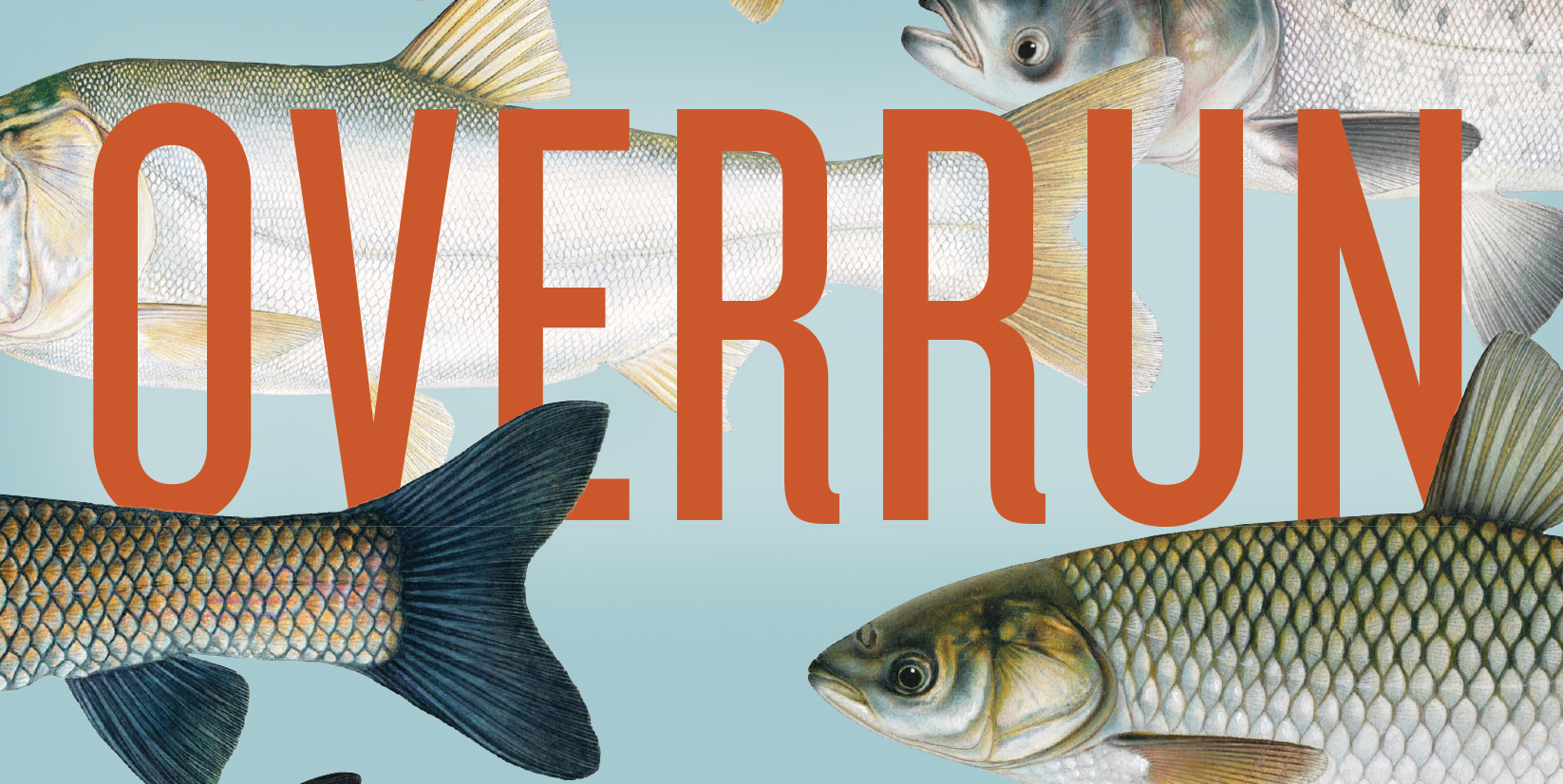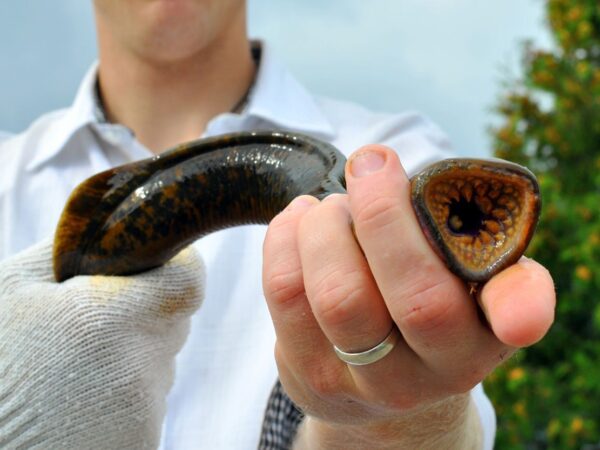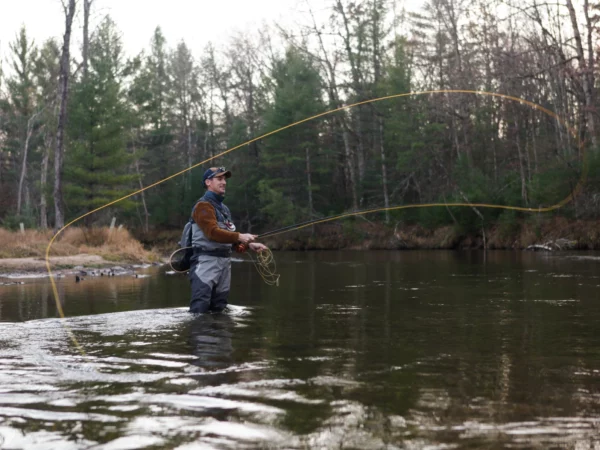
Toronto-based writer Andrew Reeves authors story of the invasive fish
The video images of the hefty fish jumping out of rivers are just a small part of the story of Asian carp, and telling the rest of the tale is what Toronto-based writer Andrew Reeves does in his new book.
With “Overrun: Dispatches from the Asian Carp Crisis,” Reeves weaves politics, history, agriculture, fish biology and several other disciplinary perspectives into the story of the invasive fish.
Reeves, a Great Lakes Now contributor, talked with GLN Program Director Sandra Svoboda about the book. Here’s an edited version of that conversation:
![]()
Sandra Svoboda: Why write a book on Asian carp? What got you interested in the issue?
![]()
Andrew Reeves: I wrote a magazine feature about Asian carp back in 2012 for This Magazine, called “Attack of the killer carp,” and I realized early on that the handful of people I was able to interview barely scratched the surface of the issue and the depth of players involved. And the more I researched that piece, the more I discovered there was a lot of misinformation out there, especially about how the fish had made it into open waters throughout the United States.
![]() What was happening around the Great Lakes to deal with the potential invaders at that time?
What was happening around the Great Lakes to deal with the potential invaders at that time?
![]() By early 2014, the Army Corps of Engineers was also shopping around the Great Lakes Mississippi River Interbasin Study, which, among other things, proposed spending $18 billion to hydrologically separate the Great Lakes from the Mississippi River. I started thinking about these two issues and realized how strange it seemed to me that Americans may soon be asked to finance $18 billion over 25 years to combat a family of invasive fish when popular media at the time was routinely getting basic facts about how they spread throughout the country wrong.
By early 2014, the Army Corps of Engineers was also shopping around the Great Lakes Mississippi River Interbasin Study, which, among other things, proposed spending $18 billion to hydrologically separate the Great Lakes from the Mississippi River. I started thinking about these two issues and realized how strange it seemed to me that Americans may soon be asked to finance $18 billion over 25 years to combat a family of invasive fish when popular media at the time was routinely getting basic facts about how they spread throughout the country wrong.
It didn’t seem to me that enough people were equipped to make these kinds of tough decisions where there was so much misinformation – or, conversely, when so much of the media coverage focused on how strange it is that silver carp jump. And while leaping silver carp make for a good visual, I was worried that something so ecologically series for the continent’s waterways was at risk of being made into a joke.
So in early 2014 I decided to do what I had been unable to do the year before – namely, to leave my job to focus full time on researching and writing about these fish. The end result comes from four years of research in 10 states and one province, in addition to archival research, interviews with over seven dozen biologists, chefs, fishers, politicians, engineers, and others working on various facets of the carp crisis, is Overrun.
![]() What surprised you most in what you found in your reporting and research?
What surprised you most in what you found in your reporting and research?
![]() How deeply involved government agencies and universities were in the early days in introducing and spreading bigheaded and grass carp. The common and somewhat lazy narrative you’ll see occasionally is that aquaculturists brought the fish over in the 1960s and didn’t think enough about what impact they would have in open freshwater ecosystems.
How deeply involved government agencies and universities were in the early days in introducing and spreading bigheaded and grass carp. The common and somewhat lazy narrative you’ll see occasionally is that aquaculturists brought the fish over in the 1960s and didn’t think enough about what impact they would have in open freshwater ecosystems.
But the more I dove into the research the clearer it became how complicit federal agencies like U.S. Fish and Wildlife Service, state agencies like the Arkansas Game and Fish Commission, and universities like Auburn were in culturing Asian carp. With grass carp, they got so good at rearing them in hatcheries that it ultimately became impossible for them to contain them all, leading to escapes. Or, in the case of Auburn, they grew more than they could safely keep and handed them out to “various persons” outside the university. Biosecurity never factored into the discussion at all, it seems.
Yes, private fish producers played a role in the import and release of Asian carp as well – but the share of the blame that’s been foisted on them now strikes me as inappropriate.
![]() How does the Asian carp “issue,” so to speak, affect people differently in different parts of the Great Lakes Region?
How does the Asian carp “issue,” so to speak, affect people differently in different parts of the Great Lakes Region?
![]() In Chicago, this has become the new ground zero, as it were, for Asian carp. A study from the Army Corps earlier this decade identified Chicago and the Chicago River as the primary vector for Asian carp to make it to the Great Lakes. Many nonprofit and binational organizations working to combat Asian carp are based here. And it was also here that researchers from Notre Dame first deployed environmental DNA in a significant want to detect the presence of Asian carp in the Chicago River in December 2009, sparking a flurry of activity in its wake that led to lawsuits between Michigan and Illinois, new electric fences, massive fish kills with rotenone, and plans to re-reverse the river or hive it off from Lake Michigan. In Chicago, Asian carp can be seen as the barbarian at the gates, a position that makes the city’s experience with these invasive fish relatively unique in North America.
In Chicago, this has become the new ground zero, as it were, for Asian carp. A study from the Army Corps earlier this decade identified Chicago and the Chicago River as the primary vector for Asian carp to make it to the Great Lakes. Many nonprofit and binational organizations working to combat Asian carp are based here. And it was also here that researchers from Notre Dame first deployed environmental DNA in a significant want to detect the presence of Asian carp in the Chicago River in December 2009, sparking a flurry of activity in its wake that led to lawsuits between Michigan and Illinois, new electric fences, massive fish kills with rotenone, and plans to re-reverse the river or hive it off from Lake Michigan. In Chicago, Asian carp can be seen as the barbarian at the gates, a position that makes the city’s experience with these invasive fish relatively unique in North America.
In Lake Erie, I sense that there’s a strong feeling that it may already be too late. We know from many risk analysis studies that Lake Erie would provide sufficient food, suitable spawning rivers, and stable wetland habitat for all Asian carp species to flourish. And it seems like every year there’s another strong suggestion that the fish are present in new and alarming ways. Just this month the U.S. Geological Survey revealed that larval grass carp were found in the Sandusky River, alongside previous finds of eggs, juvenile, and adult grass carp in other parts of Lake Erie.
While other Great Lakes (such as Lake Superior and Lake Ontario) would be harder for Asian carp to reach or thrive in, Lake Erie stands with lakes Michigan and Huron in knowing that once Asian carp arrive, there may be little we can do to stop them.
![]() There is a lot of focus on the Great Lakes and invasive carp, but what about other areas of the United States?
There is a lot of focus on the Great Lakes and invasive carp, but what about other areas of the United States?
![]() The experience of Asian carp is just as profound in the southern United States as it is in the Great Lakes basin – yet states like Louisiana, Arkansas, or Mississippi have received a fraction of the attention and federal dollars to combat Asian carp as the Great Lakes states and Great Lake-based research institutions have. As I write in Overrun – our Great Lake focus in the fight against Asian carp has been useful in bringing needed attention to these invasive fish, but we’re fooling ourselves if we think that our outdoor way-of-life in Michigan or Minnesota or Ontario is somehow different or worth more than the same way-of-life in Louisiana.
The experience of Asian carp is just as profound in the southern United States as it is in the Great Lakes basin – yet states like Louisiana, Arkansas, or Mississippi have received a fraction of the attention and federal dollars to combat Asian carp as the Great Lakes states and Great Lake-based research institutions have. As I write in Overrun – our Great Lake focus in the fight against Asian carp has been useful in bringing needed attention to these invasive fish, but we’re fooling ourselves if we think that our outdoor way-of-life in Michigan or Minnesota or Ontario is somehow different or worth more than the same way-of-life in Louisiana.
Scroll through the StoryMap to learn more about the impact of Asian Carp around the country.
![]() From what we’ve learned and how we’ve managed other invasive species, how is any of that being applied to Asian carp?
From what we’ve learned and how we’ve managed other invasive species, how is any of that being applied to Asian carp?
![]()
Sea lamprey become the obvious parallel here, though the comparison is not a perfect one. Often sea lamprey are held up as a success story when any discussion of how to halt a Great Lakes invasive species is had, though spending $20 million each year or more for the rest of time to reduce the ecological impact a single nuisance aquatic species can be difficult for some people to see as successful.
That’s likely why in Canada, at least, the people running the Department of Fisheries and Oceans have been so keen to talk about the importance of keeping Asian carp from reaching the Great Lakes, rather than what we might do to mitigate their impacts once established. Ontario, for example, or even Michigan are at a very different phase in Asian carp’s invasion trajectory than Illinois or Indiana, where the fish have been found in open waters throughout the southern reaches of each state. It sounds cliché, but there is real value for DFO or the State of Michigan to focus on prevention of Asian carp before talking about what piscicides or fishing methods or carbon dioxide deterrents can be deployed against them.
![]() Because the Lakes are an international system of freshwater, how does that complicate Asian carp management?
Because the Lakes are an international system of freshwater, how does that complicate Asian carp management?
![]() In some respects, it seems as though the importance of taking action against Asian carp has helped to smooth out some of the characteristic wrinkles you would normally find when working on a binational environmental issue. Few are on the side of Asian carp, so to speak, and so it’s easier for organizations in states through the basin and into Canada to work with binational agencies and federal governments to put forward solutions to tackling the carp crisis when there is universal agreement that something substantial must be done.
In some respects, it seems as though the importance of taking action against Asian carp has helped to smooth out some of the characteristic wrinkles you would normally find when working on a binational environmental issue. Few are on the side of Asian carp, so to speak, and so it’s easier for organizations in states through the basin and into Canada to work with binational agencies and federal governments to put forward solutions to tackling the carp crisis when there is universal agreement that something substantial must be done.
That said, there are a lot of cooks in this kitchen. The Asian Carp Regional Coordinating Committee has done great work in helping to ensure its members all pull in the same direction, but coordinating such disparate state and federal players, let alone getting them to agree on management actions, can be challenging.
But one of the first things I heard from both the former Asian carp Czar John Goss, and one of the head Asian carp researchers at the Illinois Department of Natural Resources, Kevin Irons, is that these players are all using the Asian carp crisis to fine tune how they can be better prepared to work together on the next major invasive species to threaten the basin. Because sadly, there is general agreement that of course there will be another worrying invasive in future that demands a major binational effort to curb their spread.
![]() How do you think we’ll be talking about and writing about and covering Asian carp for people in the next five, ten, twenty years?
How do you think we’ll be talking about and writing about and covering Asian carp for people in the next five, ten, twenty years?
![]() Most estimates believe that Asian carp will need between five and 20 years to become fully established in any of the Great Lakes – perhaps a bit longer for Lake Superior. So if we discover a small population of grass carp in Lake Erie tomorrow, in 20 years this conversation will have shifted from being entirely forward thinking and theoretical to well past the point where deterrence is even being discussed. At that point we’ll only be talking about ways, like with sea lamprey, to at least keep their populations in check so that any unwanted impacts on native fish species or wetlands are minimal.
Most estimates believe that Asian carp will need between five and 20 years to become fully established in any of the Great Lakes – perhaps a bit longer for Lake Superior. So if we discover a small population of grass carp in Lake Erie tomorrow, in 20 years this conversation will have shifted from being entirely forward thinking and theoretical to well past the point where deterrence is even being discussed. At that point we’ll only be talking about ways, like with sea lamprey, to at least keep their populations in check so that any unwanted impacts on native fish species or wetlands are minimal.
Yet in 20 years we could also find ourselves talking about how the series of small-scale solutions we implemented back in 2019 have proved highly effective at halting Asian carp. How we paid commercial fishers to dramatically reduce their numbers in rivers leading to the Great Lakes; how we built a market for their protein-rich flesh as fertilizer, pet (and perhaps even) human food; how we reduced the nutrient run-off from our farms into local waterways to lower the amount of nutrients available for bigheaded carp to eat; how we helped naturalize rivers and reintroduce native species like alligator gar, both of which helped reduce Asian carp populations through predation by native fishes; and how we coupled the Judas technique with the unified fishing method to get smarter in how we target overwintering populations.
We can do these things. Many of them are not as hard to implement we may think. But many will require a dramatic rethink of what we’re willing to pay to retake our waterways from Asian carp.
Editor’s Note: In her “previous life” as a writer at Detroit’s Metro Times newspaper, GLN Program Director Sandra Svoboda once ate some Asian carp. Read about that HERE.




